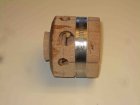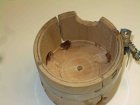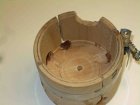One of our local mentors has a nice tutorial on making spoons, with are very much like small scoops. (This method involves turning two blanks glued together and splitting them, so the side that gets turned starts out flat)
Basically, you make a solid jig, similar to that shown in Al's video, turn a hemisphere of the desired diameter in the center of the face, then cut/drill/chisel a groove for the handle. Next you make a donut of plexiglass or masonite which gets screwed onto the face and holds the blank in place. Michael Hosaluk can make the wood stay in the jig without the donut cover, but I can't. The center hole of the donut needs to be the diameter of the inside of the scoop, so you have to cut it to leave the desired wall thickness of the scoop. There are a couple of key parts to the method, one of which is turning the ball part of the scoop to the exact diameter needed for the chuck. Another is learning to turn a proper sphere for the scoop, which is a great skill to develop. Unless you make a new chuck each time, or make a set of jigs, the scoops will all be the same size.
If you are interested in the method, a written tutorial can be found on our club website, here:
http://nrwg.org/index_files/page0006.htm The author is Tony Huckert, from world famous Manhattan, MT.
I've done some spoons and ladles by this method and you're absolutely right, Jesse, it really hurts when the handle WHACKS you on the hand. Instant learning experience! Worse than the pain is that it also often breaks the handle.



